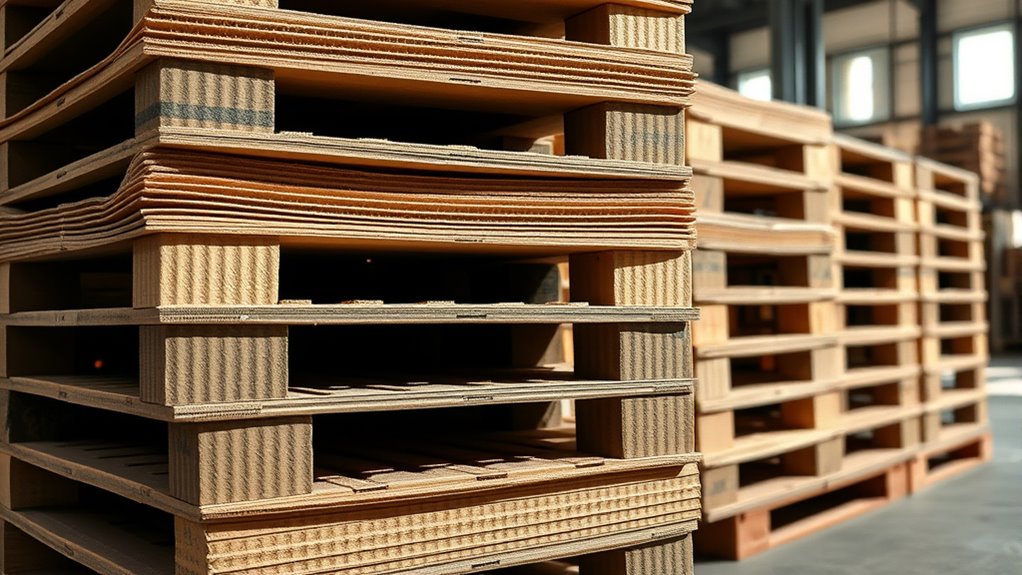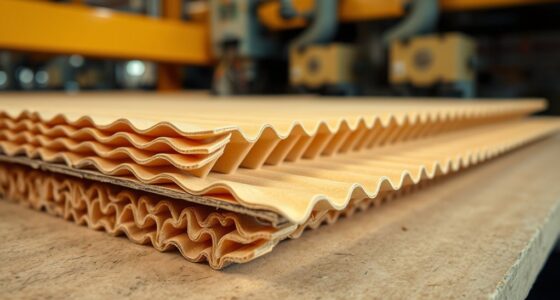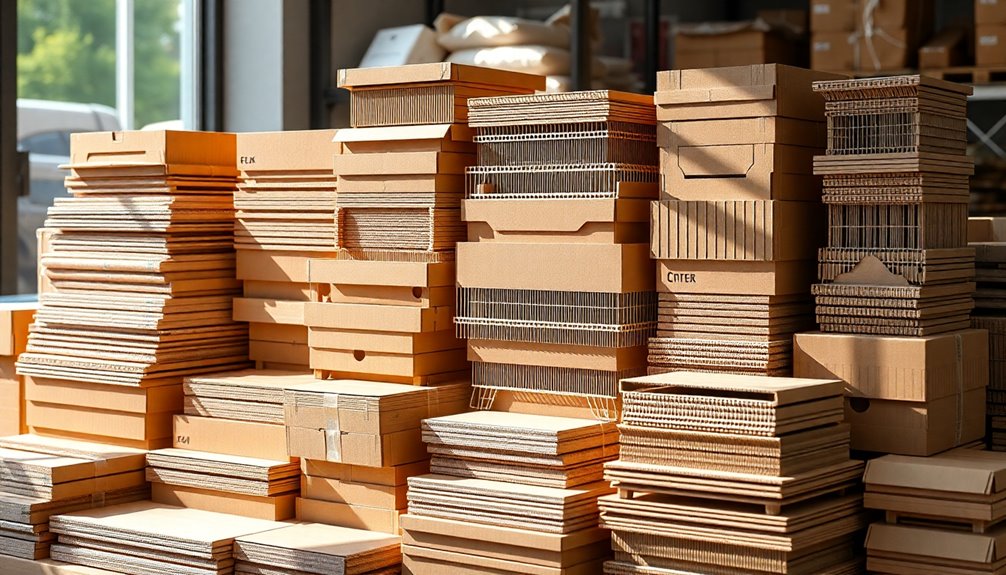Cardboard pallets are a sustainable, lightweight alternative to traditional wood pallets, making them eco-friendly choices for your supply chain. They are made from recycled and biodegradable materials, helping reduce deforestation and carbon emissions. However, they may not be as durable or moisture-resistant as wood, limiting their use for heavy or long-term applications. If you explore further, you’ll discover how these innovative options can fit your specific needs.
Key Takeaways
- Made from recycled, biodegradable materials, cardboard pallets reduce deforestation and support sustainable resource use.
- They are lightweight, lowering transportation emissions and energy consumption compared to traditional wooden pallets.
- Cardboard pallets promote recycling and reuse, contributing to a circular economy and waste reduction.
- While less durable and moisture-sensitive, innovations improve their impact resistance and reusability for eco-conscious industries.
- They serve as cost-effective, eco-friendly alternatives suitable for lightweight, sensitive, or controlled environment logistics.
What Are Cardboard Pallets and How Are They Made?
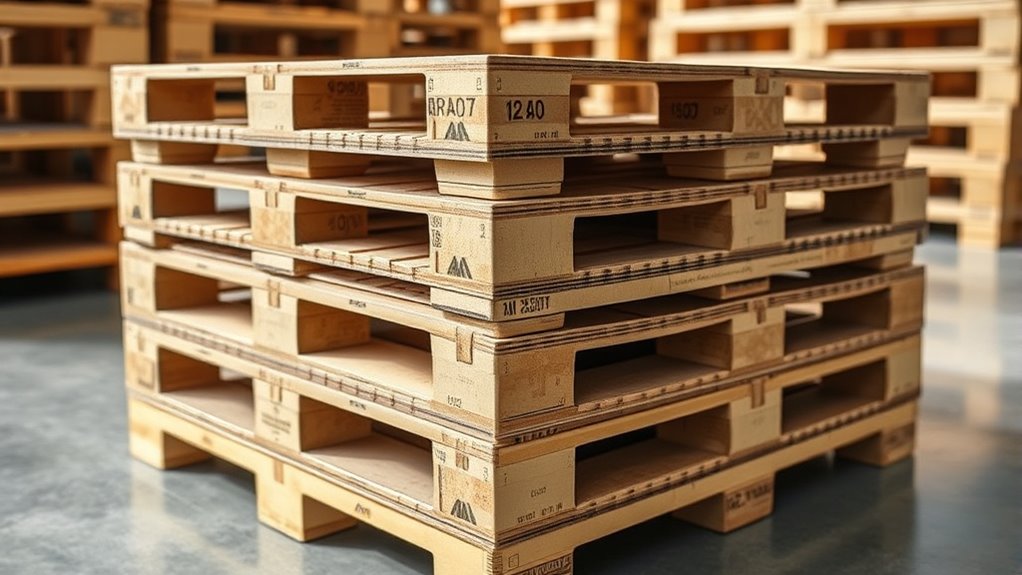
Have you ever wondered what makes cardboard pallets a popular choice for shipping and storage? It’s mainly due to their eco-friendly design and efficient manufacturing processes. Cardboard pallets are made from corrugated fiberboard, which often involves recycled paper and cardboard, supported by a robust recycling infrastructure. This setup guarantees sustainability and reduces waste. The manufacturing process includes cutting, folding, and gluing layers of corrugated material into sturdy pallet shapes. Precision machinery assembles these components quickly, creating lightweight yet durable pallets suitable for various loads. Because they’re made from recyclable materials, these pallets can be reused or recycled after use, fitting perfectly into sustainable supply chain practices. Their production emphasizes eco-conscious methods, making them an increasingly popular alternative to traditional wooden pallets. Additionally, innovations in lightweight design further enhance their environmental benefits by reducing transportation emissions.
Environmental Benefits of Using Cardboard Pallets
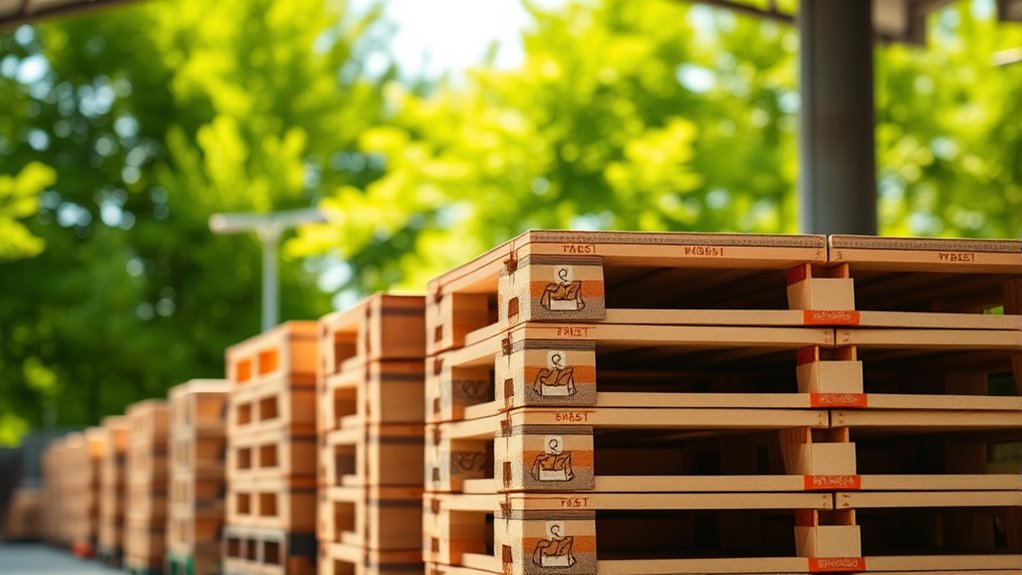
Using cardboard pallets helps reduce the impact on forests by relying on recycled materials instead of new wood. They also produce lower carbon emissions during manufacturing and transportation. Plus, they encourage recycling practices, making them an eco-friendly choice for your business.
Reduced Deforestation Impact
Because cardboard pallets are made from renewable resources, they considerably reduce the need for virgin timber, helping to lessen deforestation. This notably contributes to deforestation reduction efforts, preserving forests and biodiversity. Using recycled materials in manufacturing also lowers the ecological footprint you leave behind, since it decreases the demand for new wood harvesting. By choosing cardboard pallets, you support sustainable forestry practices and reduce the strain on forest ecosystems. Additionally, understanding patterns of behavior in how materials are sourced can help consumers make more informed sustainable choices. Incorporating eco-conscious material sourcing strategies can further enhance the environmental benefits of using cardboard pallets. Moreover, adopting sustainable sourcing practices can lead to a more circular economy, minimizing waste and promoting reuse. Overall, embracing cardboard pallets helps you minimize environmental damage associated with traditional wooden pallets, making your supply chain more sustainable and environmentally conscious.
Lower Carbon Emissions
Switching to cardboard pallets substantially lowers your carbon emissions, making your supply chain more environmentally friendly. Cardboard is a form of biodegradable packaging, which reduces the environmental impact when disposed of. Compared to wood, manufacturing cardboard pallets involves fewer energy-intensive processes, especially when produced through eco conscious manufacturing practices. This results in lower carbon footprints during production. Additionally, cardboard pallets generate less greenhouse gas during decomposition because they break down naturally. By choosing cardboard, you actively decrease your contribution to climate change. The combination of biodegradable packaging and eco conscious manufacturing means your business supports sustainability efforts without sacrificing durability or functionality. Overall, switching to cardboard pallets helps you meet environmental goals while maintaining efficient logistics. Incorporating organic methods in the production process ensures even greater environmental benefits, further reducing your ecological footprint.
Promotes Recycling Practices
By choosing cardboard pallets, you actively promote recycling practices that benefit the environment. Cardboard is highly recyclable, encouraging a circular economy where materials are reused instead of discarded. Using recycled content in manufacturing reduces waste and conserves natural resources. Cardboard pallets support eco friendly manufacturing processes, which prioritize sustainability and minimize environmental impact. When you opt for these pallets, you help create demand for recycling programs and inspire industries to adopt greener practices. This not only decreases landfill waste but also boosts the recycling industry’s growth. Your choice promotes a culture of sustainability, making recycling practices more widespread and effective. Ultimately, by selecting cardboard pallets, you contribute to a cleaner, healthier planet through responsible resource management.
Comparing Durability and Strength: Cardboard vs. Wooden Pallets
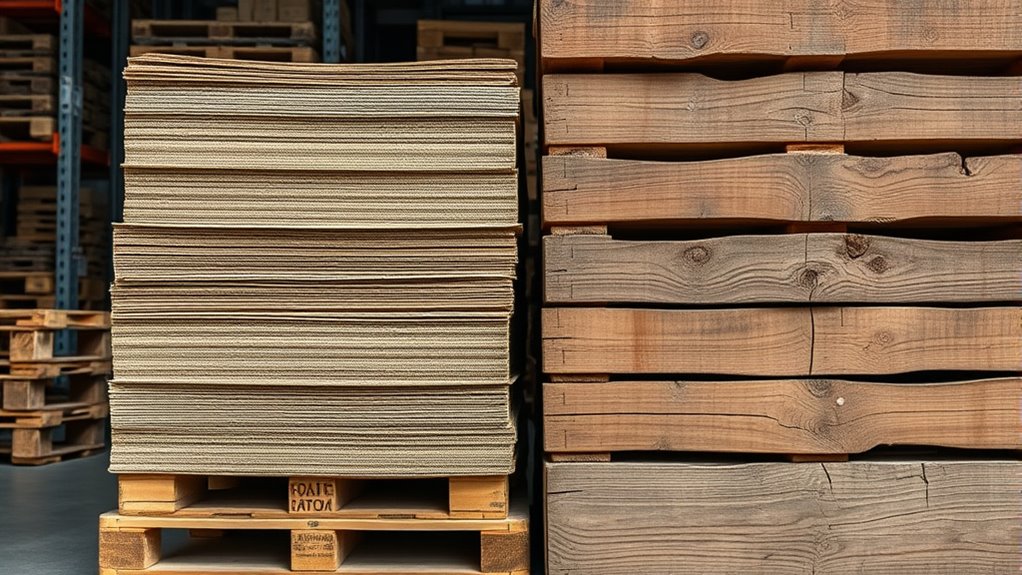
When comparing cardboard and wooden pallets, you’ll notice differences in load capacity and impact resistance. Wooden pallets typically handle heavier loads and resist damage better over time, but cardboard options can be more lightweight and cost-effective. Consider how longevity and reuse factors influence your choice for specific shipping needs.
Load Capacity Differences
While both cardboard and wooden pallets are designed to support loads, their load capacities differ markedly due to material strength. Wooden pallets generally have higher weight limits, making them suitable for heavy, bulky goods. Cardboard pallets, on the other hand, typically support lighter loads and are better for fragile items that require gentle handling. Moisture sensitivity is a key factor; cardboard pallets can weaken quickly if exposed to moisture, reducing their load capacity and risking damage to fragile items. Wooden pallets are more resistant to moisture, offering greater durability in diverse environments. If your shipments involve delicate or lightweight goods, cardboard pallets may suffice, but for heavier or moisture-sensitive loads, wooden pallets provide the added strength you need. Additionally, understanding load capacity is essential when selecting the appropriate pallet for your specific needs. Proper handling and storage conditions can also extend the lifespan of cardboard pallets, ensuring safer transportation. To optimize their performance, it’s important to consider material durability, which directly impacts their ability to withstand stress, and how it impacts overall stability during transit. Moreover, selecting pallets made from sustainable materials aligns with eco-friendly practices and can reduce environmental impact.
Impact Resistance Levels
Are cardboard and wooden pallets equally prepared to withstand impacts during handling and transit? Not quite. Wooden pallets generally have higher impact resistance due to their sturdy construction, providing better shock absorption. Their solid wood structure absorbs shocks more effectively, reducing damage during rough handling or drops. Cardboard pallets, while lightweight and eco-friendly, tend to have lower impact resistance. They’re designed for lighter loads and controlled environments. However, advancements in reinforced cardboard can improve shock absorption, making them more durable against impacts. Additionally, the impact resistance levels of pallets can vary depending on the quality and design of the materials used. For example, some reinforced cardboard pallets incorporate additional supports or layers, which can enhance their shock absorption properties. Moreover, the weight capacity of pallets also influences their impact resistance, with heavier-duty options offering better protection. Incorporating advanced reinforcement techniques can further improve their durability and impact resistance. Furthermore, the testing standards for impact resistance help determine their suitability for various applications. Still, they usually won’t match the strength of wooden pallets during heavy impacts. If your operations involve frequent or harsh handling, wooden pallets offer superior impact resistance. For lighter, eco-conscious shipping needs, cardboard can suffice, but with some trade-offs in durability.
Longevity and Reuse
Cardboard pallets generally have a shorter lifespan than wooden pallets, especially when subjected to frequent use or heavy loads. This affects their reusability concerns, as they often need replacement sooner. Wooden pallets are more durable, making them suitable for multiple uses and long-term storage. Aesthetic considerations also come into play; cardboard pallets may look less appealing after initial use, impacting presentation. Here’s a quick comparison:
| Aspect | Cardboard Pallets | Wooden Pallets |
|---|---|---|
| Reusability concerns | Limited; prone to damage | High; sturdy and durable |
| Aesthetic | May degrade quickly | Maintain appearance longer |
| Longevity | Shorter lifespan | Longer-lasting |
Your choice depends on balancing reusability, durability, and aesthetic appeal.
Cost Implications for Businesses Considering Cardboard Options
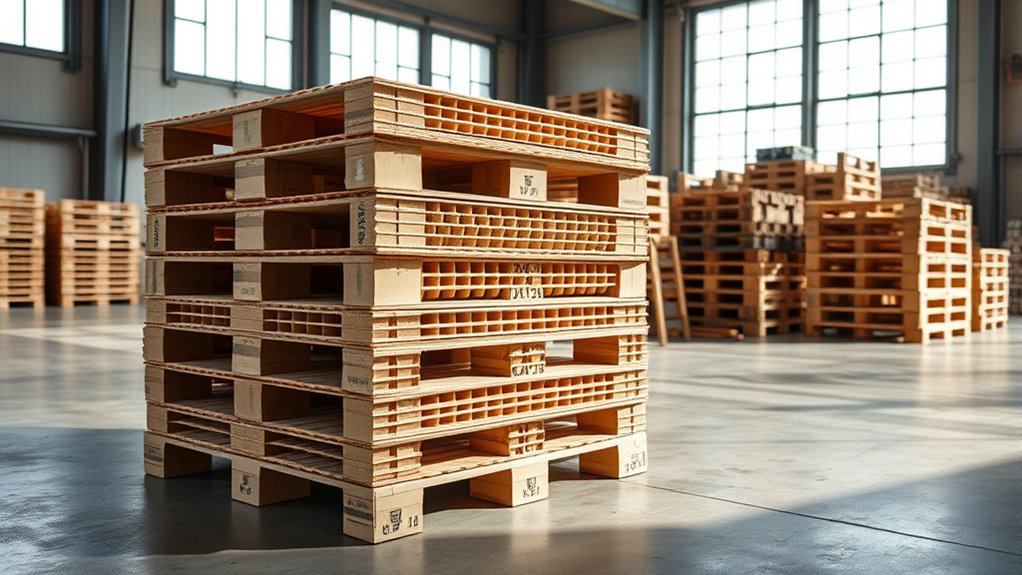
Switching to cardboard pallets can considerably impact your business’s costs, often offering both immediate savings and long-term benefits. A thorough cost analysis helps you understand how upfront expenses compare to traditional wood pallets. Cardboard pallets typically have lower purchase prices and reduce shipping costs due to their lightweight design. However, you should consider investment considerations such as durability and lifespan, which influence replacement frequency. While initial costs might seem higher for some eco-friendly options, the savings from reduced waste disposal and recycling can offset this over time. Additionally, cardboard pallets often require less storage space, cutting storage costs. Understanding the risks involved in using new materials can help you make a more informed decision. For example, assessing the financial stability of adopting eco-friendly options ensures long-term viability. Staying informed about regulatory changes related to sustainable packaging can also influence your decision-making process. Moreover, considering the availability of recycled materials can impact supply chain consistency. Incorporating eco-friendly materials such as cardboard can contribute to your company’s sustainability goals and brand image. Ultimately, evaluating these factors helps you determine if switching aligns with your budget and sustainability goals.
Recycling and Disposal: End-of-Life Considerations
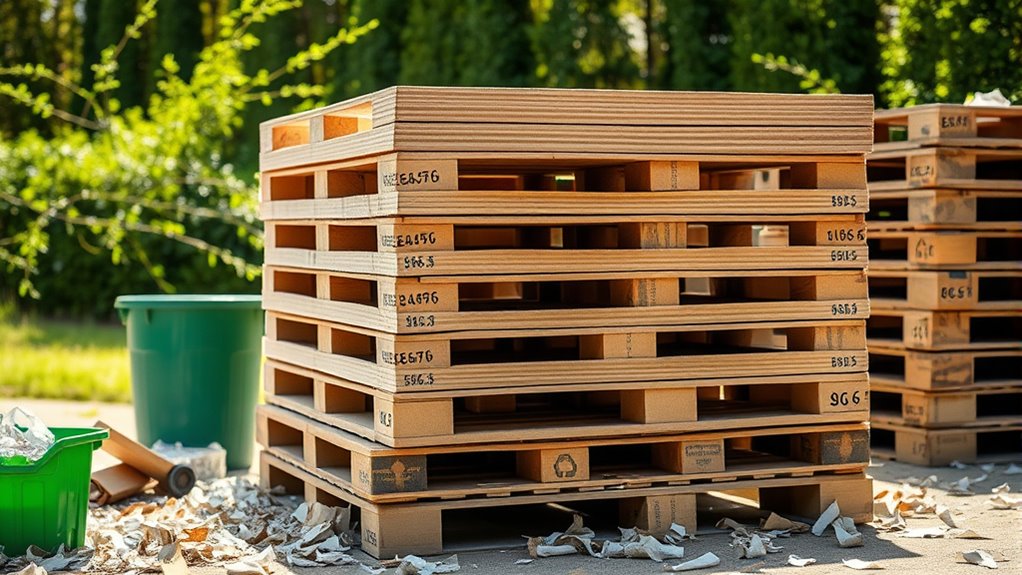
When considering the end-of-life phase for cardboard pallets, recycling and disposal become critical factors. Your options include participating in local recycling programs that accept cardboard, guaranteeing the material is properly processed and reused. Recycling reduces waste and conserves resources, aligning with eco-friendly goals. Recycling programs help ensure that cardboard is efficiently processed, reducing environmental impact. If recycling isn’t available, disposal methods like composting or landfilling are alternatives, but they are less environmentally friendly. Proper disposal helps prevent litter and environmental pollution. You should also consider how damaged or contaminated pallets are handled, as they might need special disposal procedures. Additionally, selecting appropriate disposal methods can prevent potential health hazards and environmental contamination. By choosing responsible recycling programs and appropriate disposal methods, you can minimize your ecological footprint and support sustainable waste management practices. This approach ensures cardboard pallets are disposed of efficiently and with minimal environmental impact.
Limitations and Challenges of Cardboard Pallets
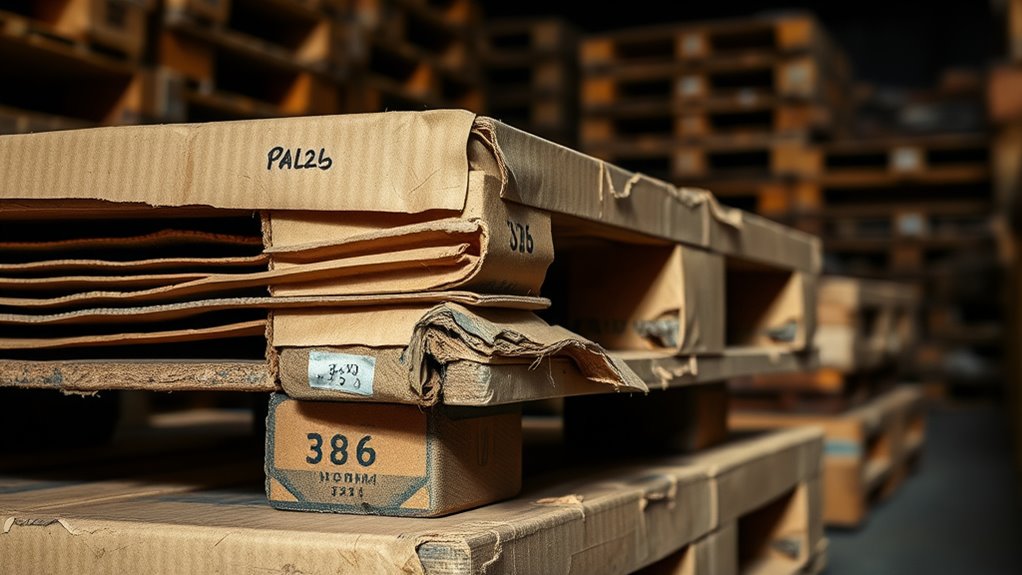
While recycling and proper disposal are essential for minimizing environmental impact, cardboard pallets face several limitations and challenges that can hinder their widespread use. Recycling challenges arise because damaged or contaminated pallets are difficult to process, reducing their recyclability. Additionally, the quality of recycled cardboard can degrade after multiple cycles, limiting durability. Manufacturing limitations also play a role; producing sturdy, load-bearing pallets requires precise design and high-quality materials, which can increase costs and complexity. Cardboard’s susceptibility to moisture and humidity further restricts their application in certain environments. These factors mean that, despite their eco-friendly appeal, cardboard pallets may not always be suitable for heavy or long-term storage needs. Overcoming these challenges is key to expanding their adoption across industries.
Industries and Applications Best Suited for Cardboard Pallets
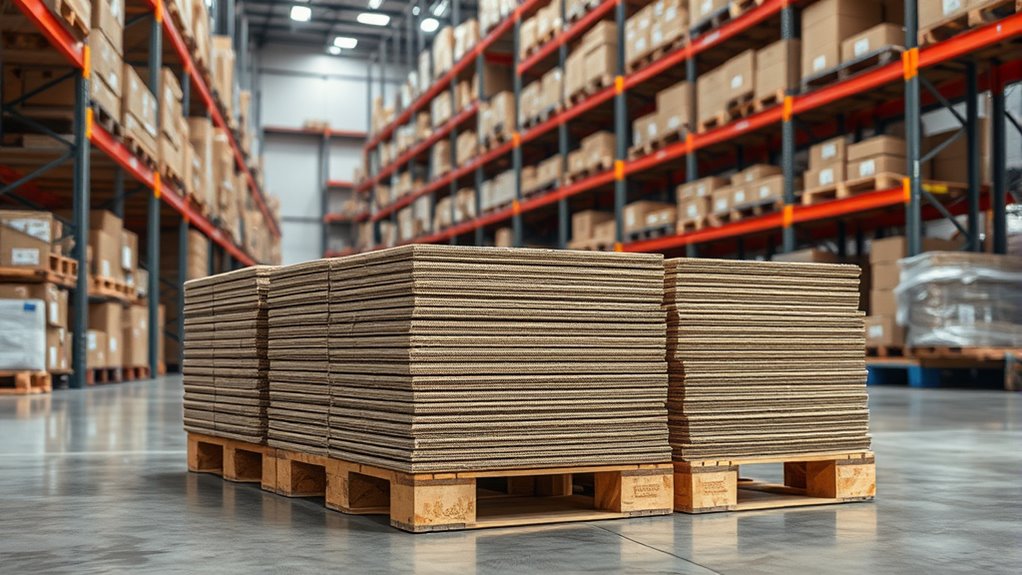
Cardboard pallets are best suited for industries and applications where lightweight, cost-effective, and eco-friendly packaging solutions are priorities. You’ll find them ideal in sectors like retail, food, and pharmaceuticals, where recycling regulations demand sustainable practices. Their lightweight nature reduces transportation costs and makes handling easier. Additionally, cardboard pallets help lower manufacturing costs because they’re cheaper to produce than traditional wood or plastic alternatives. Many companies turn to these pallets to meet environmental standards while maintaining efficiency. They’re especially useful in scenarios where products are frequently shipped and returned, as recycling and disposal become simpler. Overall, if your industry values sustainability, compliance, and cost savings, cardboard pallets offer a practical, eco-conscious option.
Innovations in Eco-Friendly Pallet Design
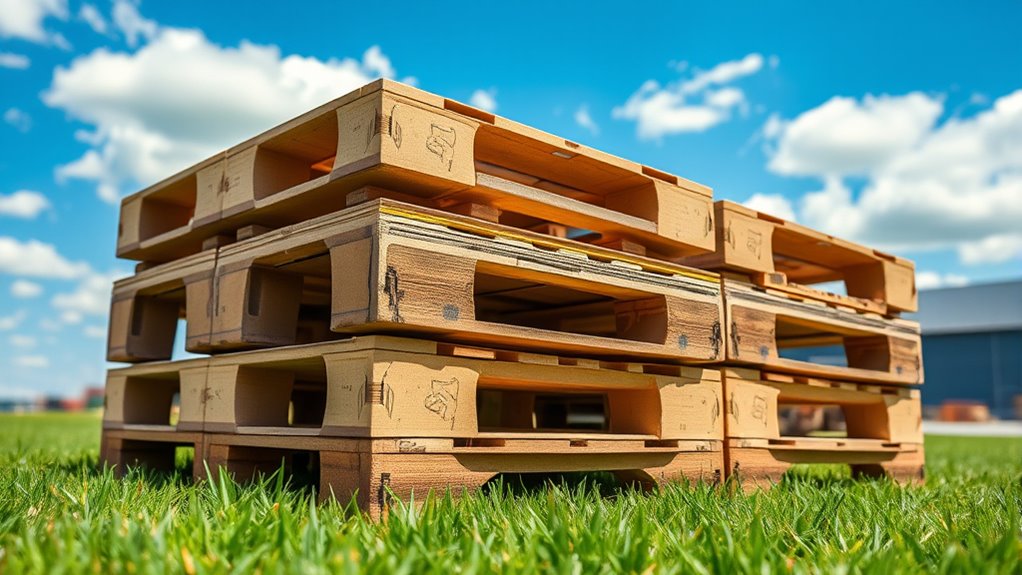
Innovations in eco-friendly pallet design are pushing the boundaries of sustainability and functionality. You’ll find that new materials and construction methods emphasize biodegradable packaging, reducing environmental impact. Advanced designs incorporate recycled fibers and biodegradable adhesives, making these pallets easier to break down at the end of their lifecycle. Manufacturers now focus on eco conscious manufacturing, minimizing waste during production and lowering carbon footprints. Some innovations include lightweight yet durable structures that decrease transportation emissions. You can also see modular designs that enhance reusability and adaptability for various industries. These advancements not only improve performance but also promote eco-friendly practices, aligning with your sustainability goals. As a result, eco-conscious companies are increasingly adopting these innovative pallets to balance operational needs and environmental responsibility.
Future Trends in Sustainable Packaging Solutions
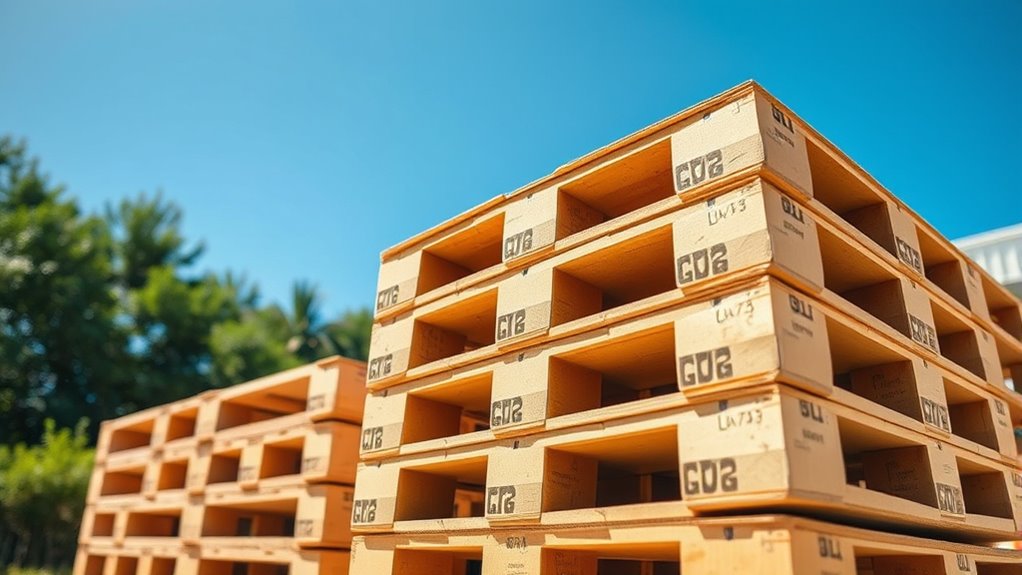
As sustainability becomes an even greater priority across industries, future trends in packaging solutions are focusing on integrating smarter, more eco-friendly materials and technologies. You’ll see innovations that optimize recycling processes, making it easier to reuse materials and reduce waste. Manufacturing techniques will evolve to incorporate lightweight yet durable materials, such as recycled cardboard and biodegradable plastics, to minimize environmental impact. Advanced automation and digital design tools will enable precise production, cutting down on excess material use. Additionally, companies are likely to adopt circular economy principles, designing packaging that can be continuously recycled or repurposed. These trends will help you reduce your carbon footprint while maintaining product protection and efficiency, making sustainable packaging solutions more accessible and effective for all industries.
Frequently Asked Questions
Are Cardboard Pallets Suitable for All Types of Cargo?
You might wonder if cardboard pallets suit all cargo types. While they excel with lightweight, non-porous items, they’re not ideal for heavy or moisture-sensitive goods. Cardboard pallets offer recyclability benefits and are often more cost-effective compared to wood. However, consider your cargo’s weight and durability needs before choosing, as they’re best for lighter loads and situations where eco-friendliness and cost comparison matter most.
How Do Cardboard Pallets Perform in Extreme Weather Conditions?
You wonder how cardboard pallets handle extreme weather. They offer decent moisture resistance, especially if treated properly, but prolonged exposure to rain or high humidity can weaken them. Their thermal insulation helps protect your cargo from temperature swings, making them suitable for some outdoor use. However, for harsh weather, it’s best to supplement with covers or indoor storage, as they’re not as durable as wood in extreme conditions.
Can Cardboard Pallets Be Customized for Specific Industry Needs?
You can definitely customize cardboard pallets to meet your industry-specific needs. They offer excellent design flexibility, allowing you to tailor dimensions, weight capacities, and branding options. This customization guarantees the pallets fit your unique logistics requirements while maintaining eco-friendly benefits. By working with manufacturers, you can develop solutions that optimize efficiency, reduce waste, and align with your sustainability goals, making cardboard pallets a versatile choice for various industries.
What Are the Safety Standards and Certifications for Cardboard Pallets?
You should know that safety standards for cardboard pallets focus on fire safety and chemical resistance. Look for certifications like UL or FM approval, which ensure they’re tested for fire hazards. Also, verify if they meet chemical resistance standards, preventing damage or safety risks during storage or transport. Ensuring these certifications helps you choose pallets that are safe, reliable, and compliant with industry regulations, reducing risks for your operations.
How Do Cardboard Pallets Impact Supply Chain Efficiency?
You’ll find that cardboard pallets boost supply chain efficiency by offering quick setup and lightweight handling. Their recyclability benefits help reduce waste, supporting sustainability goals. Compared to traditional wood pallets, they often have a favorable cost comparison due to lower transportation and disposal costs. This means you can streamline operations, cut expenses, and meet eco-friendly standards, all while maintaining reliable, effective logistics.
Conclusion
Choosing cardboard pallets is like planting seeds for a greener future—you help the environment grow stronger with each eco-friendly step. While they may not replace every wooden pallet, they offer a sustainable alternative that reduces waste and supports recycling efforts. Embracing these lightweight champions can transform your shipping practices into a ripple of positive change. So, consider cardboard pallets as your eco-friendly compass guiding your business toward a more sustainable horizon.

